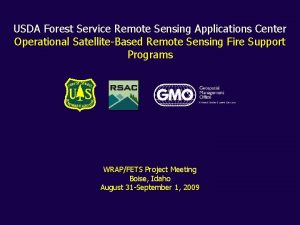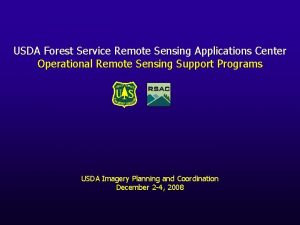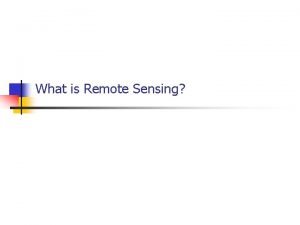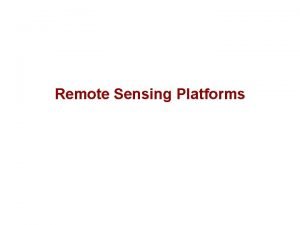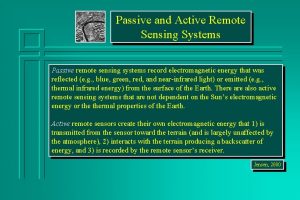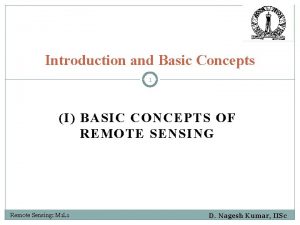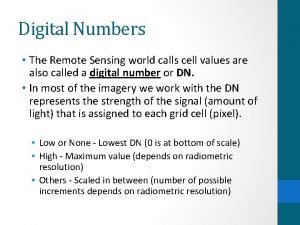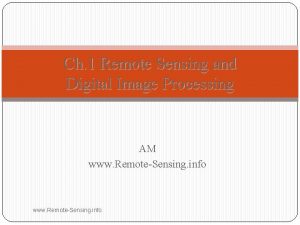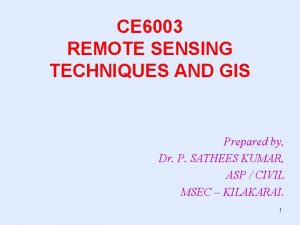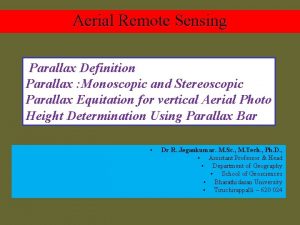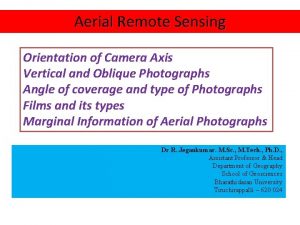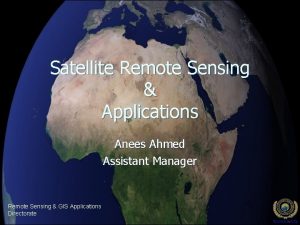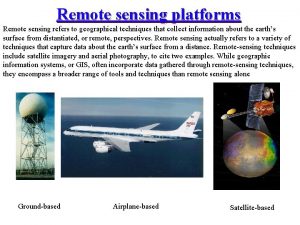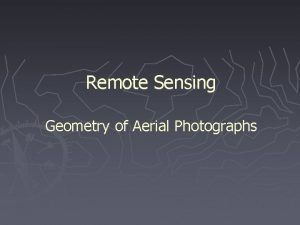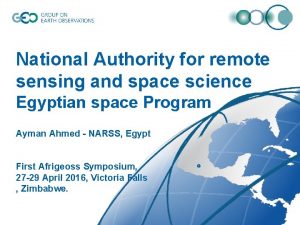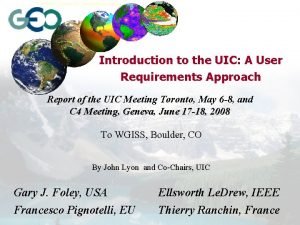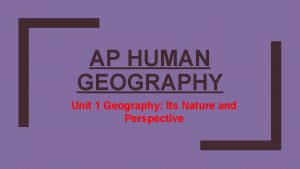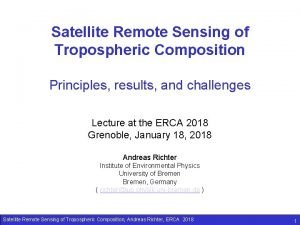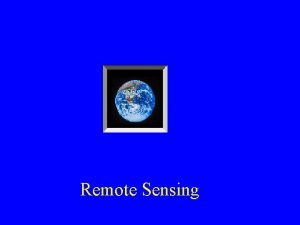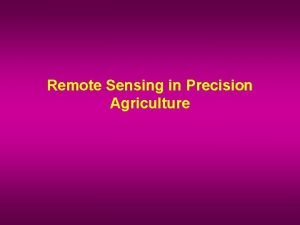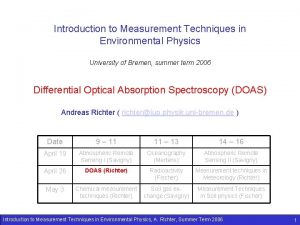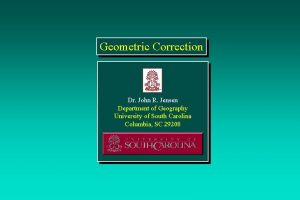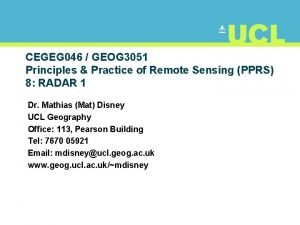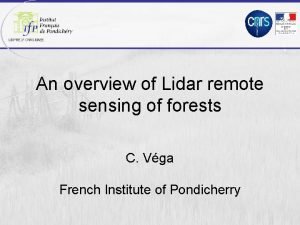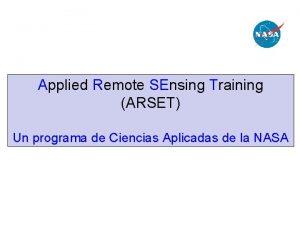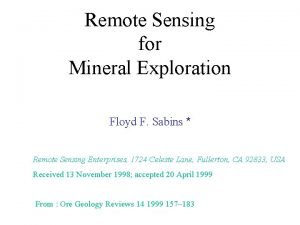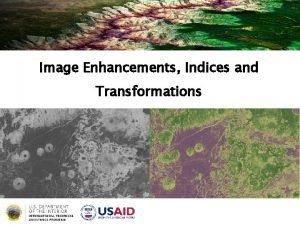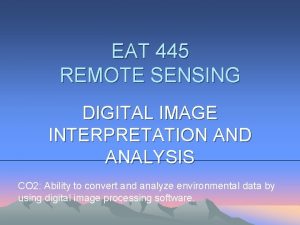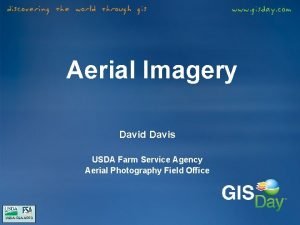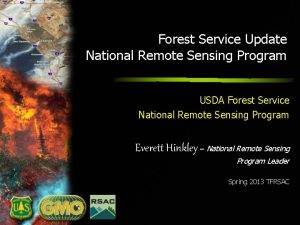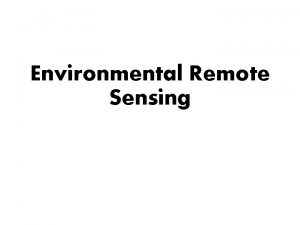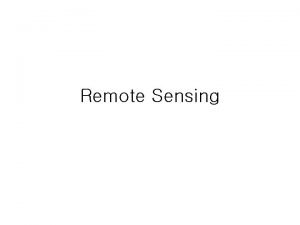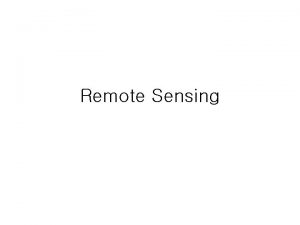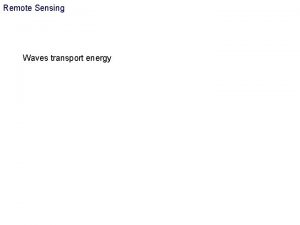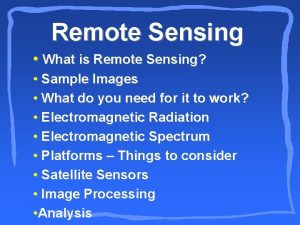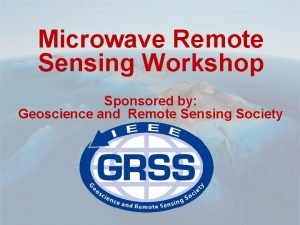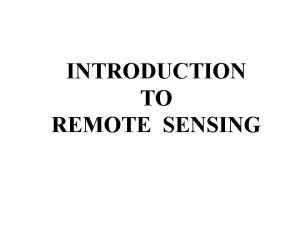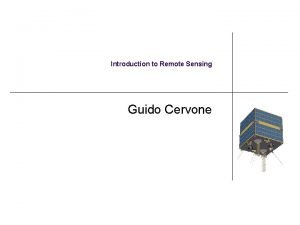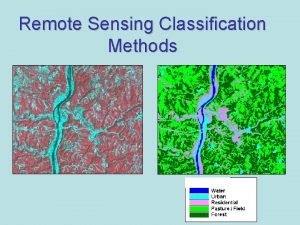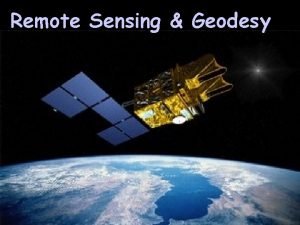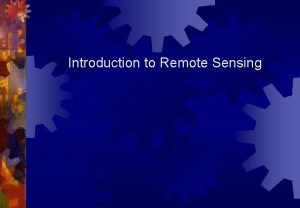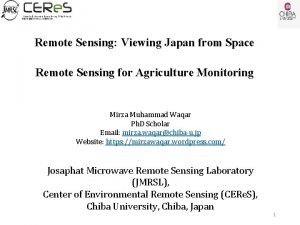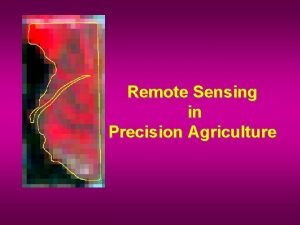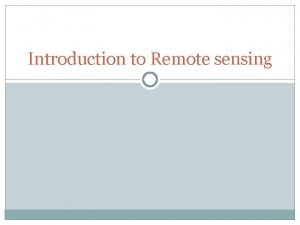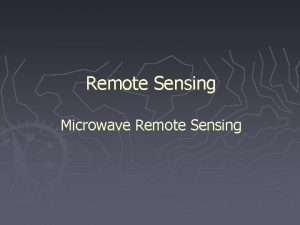USDA Forest Service Remote Sensing Applications Center Operational


































- Slides: 34

USDA Forest Service Remote Sensing Applications Center Operational Remote Sensing Support Programs USDA Imagery Planning and Coordination December 2 -4, 2008

Remote Sensing Applications Center (RSAC) RSAC Mission: l Technical support - evaluating and developing remote sensing, image processing, GPS, and related geospatial technologies. l Project support and assistance using remote sensing technologies. l Technology transfer and training to field users. l Operational support for active wildland fire management and post-fire assessment.

RSAC Operations Program Support Active Fire Assessment l MODIS Active Fire Mapping Program u Support USFS and all wildland fire management agencies q Near Real-time Assessment Post-fire Assessment l Burned Area Emergency Response (BAER) Imagery Support u Support USFS BAER teams q l Emergency Assessment Rapid Assessment of Vegetation Condition after Wildfire (RAVG) u Support Forest Silviculturists q Rapid Assessment Post-Catastrophic Wx Event Assessment l Rapid Assessment of Forest Damage u Support USFS units (National Forests/Districts) q Rapid Assessment

RSAC Operations Program Support Currently Leveraged Sensor Assets Landsat 5 and Landsat 7 (SLC-Off) ASTER SPOT 4 and 5 AWi. FS NASA Ikhana AMS Disaster Monitoring Constellation (DMC) MASTER AWi. FS IKONOS Quickbird MODIS AVHRR GOES DMC L 5 ASTER SPOT 5 Ikhana MODIS

Forest Service MODIS Active Fire Mapping Program l Satellite-based operational detection and monitoring of wildland fire activity in CONUS, Alaska, Hawaii & Canada • Generate and provide "value added” fire mapping and visualization products, and geospatial data • Facilitates decision support for strategic wildfire planning and response for U. S. and Canadian fire agencies u u u Prioritize allocation of fire suppression assets Focus tactical airborne reconnaissance assets Supports several fire-related applications and decision support systems

Forest Service MODIS Active Fire Mapping Program Currently Leveraged Sensor Assets Sensor Platform Type Spatial Resolution Temporal Resolution (Reflectance/TIR Bands) (per instrument) Fire Algorithm Data Source MODIS Polar orbiting 250 m, 500 m, 1 km/1 km 2 times daily MOD 14/MYD 14 Direct Readout; NASA Rapid Response System AVHRR Polar orbiting 1 km/1 km 2 times daily FIMMA NOAA NESDIS GOES Geostationary 1 km/4 km 4 times hourly WF-ABBA NOAA NESDIS VIIRS* Polar orbiting 375 m/750 m 2 times daily TBD Direct Readout; Rapid Response GOES-R# Geostationary 500 m, 1 km/2 km 4 times hourly TBD Direct Readout; NOAA NESDIS * VIIRS launch on NPOESS Preparatory Project (NPP) mission in June 2010 and subsequent NPOESS missions # GOES-R launch in 2015 and subsequent missions

MODIS Fire & Thermal Anomalies (MOD 14/MYD 14) • See Giglio et al. (2003) in • Detects & characterizes fire at 1 km spatial resolution • Leverages response of 4 m and 11 m bands to fire • Absolute thresholds and contextual analysis • Fire detection is affected by several variables Remote Sensing of Environment u Central Idaho Aug 12, Idaho 2007 Central False. Aug Color Central Idaho 12, Composite 2007 (1 -KM detection Aug 12, 2007 False Color Composite centroids in yellow) True Color Composite (Active fires in orange) • Atmospheric conditions, view angle, land cover, overpass time relative to fire activity, etc. Fire activity smaller than 1 km can be detected u u 100 m 2 flaming fire (50% probability) 50 m 2 flaming fire in ideal viewing conditions (~100% probability)

RSAC MODIS Direct Broadcast/Direct Readout May 18, 2008 daytime MODIS acquisitions by RSAC ground station NASA Simulcast Viewer Direct Broadcast (DB) Real-time transmission of satellite data to the ground. As the Earth is being observed by the satellite, the data is formatted and transmitted to any user below in real-time. Direct Readout (DR) Acquisition of freely transmitted live satellite data by users with compatible ground receiving equipment and direct line of sight to the satellite.

MODIS Direct Readout Ground Station Network Area of interest for MODIS Active Fire Mapping Program… UAF RSAC Continuously acquire L 0/L 2 MODIS data at RSAC further processing… Ground Station Network USDA Forest Service Remote Sensing Applications Center (RSAC) NASA GSFC Direct Readout Lab (GSFC) University of Wisconsin Space Science Engineering Center (SSEC) University of Alaska Fairbanks (UAF) NASA MODIS Rapid Response System provides global coverage; backs up ground station network SSEC GSFC

Forest Service MODIS Active Fire Mapping Program Value-Added Mapping/Visualization Products and Geospatial Data • Printable maps • Interactive web maps • KMLs • Fire detection GIS data • True & False color image subsets • Analysis Products Northern California – June 27, 2008

MODIS Active Fire Mapping Program Usage USDA MODIS Active Fire Mapping Program Website Stats 2001 -2008 # * * # * - complete statistics not available for 2001; # - statistics through November 27, 2008

Burned Area Emergency Response (BAER) l Objective is to prescribe and implement emergency stabilization measures in order to prevent further damage to life, property and natural resources l BAER teams are deployed to fires where special efforts are required to mitigate potential hazards resulting from fire effects l Post-fire damage assessment u u u l l Focus on soil and water quality effects Calculate potential erosion and debris flows Determine values at risk downstream Identifies priority areas to be treated Straw waddles on Pike-San Isabel NF Determine appropriate treatments that help to mitigate some of the risk Response plan is required within 7 days of fire containment RSAC remote sensing support is critical in generating the BAER response plan Contour logging on Shasta-Trinity NF

Burned Area Emergency Response Imagery Support • Objective is to provide rapid delivery of remote sensing products to Forest Service BAER teams u Pre-/Post-fire satellite imagery u Burned Area Reflectance Classifications (BARC) u Other relevant geospatial data and products l RSAC remote sensing support provided at or immediately after fire containment l RSAC provides imagery and data products within 24 hours of image acquisition l Multiple BAER teams/wildland fire incidents are supported simultaneously by RSAC l Critical technical factors: u u Spatial resolution – 20 to 30 m Spectral resolution – SWIR band Acquisition timing – at or near fire containment Delivery from provider – FTP; same day of acquisition

Burned Area Emergency Response Imagery Support Frequently Leveraged Sensor Assets Sensor Platform Type Spatial Resolution Temporal Resolution (per (Reflectance Bands) instrument) Data Source Landsat 5 Polar orbiting 30 m 16 days USGS EROS Landsat 7 (SLC-off) Polar orbiting 30 m 16 days USGS EROS AWi. FS Polar orbiting 56 m 5 days USDA-FAS-SIA SPOT 4 Polar orbiting 20 m 2 -3 days (pointable) SPOT Image SPOT 5 Polar orbiting 10 m/20 m 2 -3 days (pointable) SPOT Image ASTER 1 Polar orbiting 15 m/30 m 4 -16 days (pointable) NASA/USGS EROS NASA AMS Airborne (UAV) ~ 21 m -- NASA LDCM 2 Polar orbiting 30 m 16 days USGS EROS 1 – Anomalous SWIR band issues since April 2008; 2 - LDCM launch currently scheduled for July 2011

Creation of the BARC Prefire Postfire d. NBR BARC Black Pine 2 Fire Sawtooth NF 73, 000 Acres Normalized Burn Ratio (NBR) Differenced Normalized Burn Ratio (d. NBR) NBR = (NIR – SWIR) / (NIR + SWIR) d. NBR = Pre NBR – Post NBR Normalized Difference Vegetation Index (NDVI) Differenced NDVI (d. NDVI) NDVI = (NIR – Red) / (NIR + Red) Unburned to Low d. NDVI = Pre NDVI – Post NDVI Low Moderate High d. NDVI is utilized when appropriate SWIR band is not available

Burned Area Emergency Response Imagery Support BAER Support Rapid Delivery Products Prefire Image Postfire Image d. NBR or d. NDVI Image BARC Image 3 D Visualizations Map Products

Burned Area Emergency Response Imagery Support BAER Imagery Support Statistics (2001 -2008) USGS-EROS Year Fires USFS-RSAC Acres Fires Acres Sum Fires Acres 2001 5 N/A 15 310, 500 2002 10 500, 000 73 2, 710, 599 83 3, 210, 599 2003 17 307, 034 54 1, 637, 471 71 1, 944, 505 2004 24 5, 000 25 471, 102 49 5, 471, 102 2005 23 800, 000 46 734, 559 69 1, 534, 559 2006 61 2, 532, 907 115 2, 470, 856 176 5, 003, 763 2007 48 2, 422, 130 106 3, 508, 407 154 5, 930, 537 Sum 188 11, 562, 071 434 11, 841, 324 622 23, 405, 565 Collaborative effort between USFS-RSAC and USGS-EROS So far this year (2008): 97 fires, 1. 7 million acres of USFS support

Post-Fire Vegetation Management on National Forest System Lands l Available resources to support reforestation in burned areas are limited, consequently, better prioritization is needed USFS Region 5 facilitated a protocol for rapid identification of deforestation and reforestation need on National Forest System lands • Post-fire damage assessment l u u Leverage relationship of satellite-based burn severity observations to CBI field data that quantify fire effects to vegetation (deforestation) Spatially represent forested vs. deforested areas following wildfire q u Levels of deforestation Silviculturists use as a tool to identify and prioritize land suitable for reforestation q q Natural Recovery Assisted Recovery (planting, seeding or site preparation for natural recovery) Ken Marchand (USFS)

Rapid Assessment of Vegetation Condition after Wildfire (RAVG) • Objective is to provide timely geospatial and tabular summary products of fire effects on forest resources to silviculturists u Pre-Fire/Post-fire imagery and burn severity data u % basal area loss data/maps u Summary tables of vegetation groups, by % basal area change (basal area loss) land status and slope l RSAC conducts a RAVG assessment on fires where > 1, 000 acres of NFS forested land is affected l RSAC provides RAVG data and summary products within 30 days of fire containment l Multiple fires are supported simultaneously by RSAC l Critical technical factors: u u u Spatial resolution – 20 to 30 m Spectral resolution – SWIR band Acquisition timing - ~ 2 weeks following fire containment

Rapid Assessment of Vegetation Condition after Wildfire Frequently Leveraged Sensor Assets Sensor Platform Type Spatial Resolution Temporal Resolution (Reflectance Bands) (per instrument) Data Source Landsat 5 Polar orbiting 30 m 16 days USGS EROS Landsat 71 (SLC-off) Polar orbiting 30 m 16 days USGS EROS AWi. FS Polar orbiting 56 m 5 days USDA-FAS-SIA LDCM 2 Polar orbiting 30 m 16 days USGS EROS 1 - Used only if fire area is outside of SLC-off affected area of image 2 – LDCM launch currently scheduled for July 2011

Creation of RAVG Analysis Products Prefire Postfire Image. Area Mortality Image Rd. NBR Image 7 Class Image Basal Rombo Mtn Fire Bitterroot NF 28, 000 Acres Normalized Burn Ratio (NBR) NBR = (NIR – SWIR) / (NIR + SWIR) Relative Differenced Normalized Burn Ratio (Rd. NBR) Rd. NBR = Summary GIS Analysis Using: - 7 Class % Change in Basal Area Ownership / Land Status LANDFIRE Existing Vegetation Groups Slope (Pre NBR – Post NBR) Square. Root(ABS(Pre NBR / 1000))

Rapid Assessment of Vegetation Condition after Wildfire Primary RAVG Product Deliverables Vegetation/Burn Severity Summaries Forested/Deforested Map Products

Rapid Assessment of Vegetation Condition after Wildfire RAVG Support Statistics (2007 -2008) Year Fires Acres 2007 63 2, 819, 158 2008 54 1, 369, 677 Sum 117 4, 188, 835

Post-Catastrophic Wx Event Assessments • Hurricanes can cause significant forest damage in National Forest System Lands of the southeastern United States • RSAC is currently evaluating rapid response, moderate resolution change detection assessments forested areas in the immediate aftermath of hurricanes and other catastrophic weather events (ice storms, etc. ) • Post Wx event damage assessment u Identify areas of potential forest damage that can be targeted/evaluated for salvage harvesting, fuel treatments and habitat restoration

Post-Catastrophic Wx Event Assessments • Objective is to provide change detection products to NFS units within two weeks of storm event l u Pre-Fire/Post-event imagery u Change detection products Feasibility evaluation is ongoing u Analysis of 2008 events u Analysis of selected pre-2008 events l Conduct on impacted NFS lands and utilize field verification data provided by National Forests l Critical technical factors: u u Spatial resolution –moderate to coarse Spectral resolution – SWIR band is desirable Acquisition timing - ~ 2 weeks following fire containment Pre/Post-event images – near nadir observations (optimum) with similar sensor geometry characteristics

Post-Catastrophic Wx Event Assessments Frequently Leveraged Sensor Assets Sensor Platform Type Spatial Resolution Temporal Resolution (Reflectance Bands) (per instrument) Data Source MODIS Polar orbiting 250 m/500 m 2 times daily RSAC/NASA AWi. FS Polar orbiting 56 m 5 days USDA-FAS-SIA VIIRS 1 Polar orbiting 375 m 2 times daily Direct Readout; NOAA/NASA 1 - VIIRS launch on NPOESS Preparatory Project (NPP) mission in June 2010 and subsequent NPOESS missions

MODIS 10/24/05 -9/4/05 Average Change in NDFI: NDFI = ( NDVI + NDMI ) / 2 More Change Less Change Immediate Change Detection

Landsat 7 10/22/05 -9/4/05 Average Change in NDFI: NDFI = ( NDVI + NDMI ) / 2 More Change Less Change Immediate Change Detection

MODIS 10/24/05 -9/4/05 Average Change in NDFI: NDFI = ( NDVI + NDMI ) / 2 More Change Less Change Immediate Change Detection

MODIS 10/24/05 -9/4/05 Average Change in NDFI: NDFI = ( NDVI + NDMI ) / 2 More Change Salvage Areas Less Change

LANDSAT 10/22/05 -9/4/05 Average Change in NDFI: NDFI = ( NDVI + NDMI ) / 2 More Change Salvage Areas Less Change

RSAC Operations Program Support Challenges and Concerns l Landsat data continuity w w l Transition to commercial assets w w l Landsat 5 longevity LDCM launch schedule Availability of 2. 1 micron SWIR band Image costs Timely product delivery Availability of data archive Transition from MODIS to VIIRS w w w Terra and Aqua MODIS longevity Launch schedule for NPP/NPOESS VIIRs VIIRS technical issues

Additional Information RSAC Operations Program Brian Schwind bschwind@fs. fed. us BAER Imagery Support Jess Clark jtclark@fs. fed. us MODIS Active Fire Mapping Brad Quayle bquayle@fs. fed. us RAVG Support Tony Guay tguay@fs. fed. us Post-Catastrophic Storm Assessment Chuck Werstak cwerstak@fs. fed. us http: //www. fs. fed. us/eng/rsac/baer http: //frdev. ftcol. wo. fs. fed. us/postfirevegco ndition/index. php http: //activefiremaps. fed. us

Extra
 Remote sensing applications center
Remote sensing applications center Remote sensing applications center
Remote sensing applications center Energy transfer
Energy transfer Remote sensing platforms
Remote sensing platforms Active vs passive remote sensing
Active vs passive remote sensing Ideal remote sensing system
Ideal remote sensing system Digital number in remote sensing
Digital number in remote sensing Limitations of remote sensing
Limitations of remote sensing Idealized remote sensing system
Idealized remote sensing system Proportional symbol map ap human geography
Proportional symbol map ap human geography Global positioning system ap human geography
Global positioning system ap human geography Parallax bar
Parallax bar Strip camera in remote sensing
Strip camera in remote sensing Remote sensing image
Remote sensing image Ifov and fov in remote sensing
Ifov and fov in remote sensing Geometry of aerial photograph
Geometry of aerial photograph National authority for remote sensing and space sciences
National authority for remote sensing and space sciences Canada centre for remote sensing
Canada centre for remote sensing Geospatial data ap human geography
Geospatial data ap human geography Remote sensing physics
Remote sensing physics Microwave remote sensing lecture notes
Microwave remote sensing lecture notes Remote sensing in precision agriculture
Remote sensing in precision agriculture Aerial photography in remote sensing pdf
Aerial photography in remote sensing pdf Introduction to microwave remote sensing
Introduction to microwave remote sensing Remote sensing physics
Remote sensing physics Tangential scale distortion
Tangential scale distortion Remote sensing
Remote sensing Full waveform lidar
Full waveform lidar Remote sensing
Remote sensing Applied remote sensing training program
Applied remote sensing training program Advantages of remote sensing
Advantages of remote sensing Remote sensing
Remote sensing Digital interpretation in remote sensing
Digital interpretation in remote sensing Farm production and conservation business center
Farm production and conservation business center Usda farm service agency maps
Usda farm service agency maps
